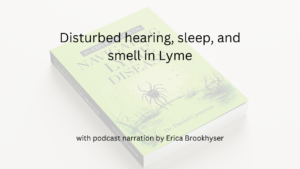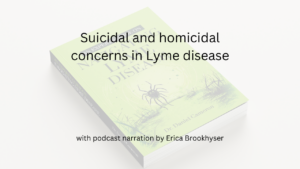Call for your appointment today 914-666-4665 | Mt. Kisco, New York

Welcome to an Inside Lyme case study. I find that the best way to get to know Lyme disease is through reviewing actual cases. In this case study, I will be discussing two babies who contacted Babesia from their mothers. This case affords a discussion Lyme disease during pregnancy.This case series will be discussed on my Facebook and made available on podcasts and YouTube.
In this episode, I will be discussing two children who contracted Babesia from their mothers.
These cases were described in the Journal of the Pediatric Infectious Disease Society, written by Saetre and colleagues in 2017.
Babesia is caused by a parasite called Babesia microti. Babesia is typically contracted from the bite of a deer tick. In early cases of Babesia, the parasite may be seen in the red cells by looking at a thick smear of blood under the microscope. In other cases, Babesia can only be detected by a DNA test called a PCR or an antibody test. In some instances, Babesia may not be detected by any of these tests. Babesia can be severe and, in rare cases, fatal. Babesia can also be mild or without symptoms. In some cases, Babesia can be transmitted through a blood transfusion and during pregnancy.
[bctt tweet=”Babesia can be severe and, in rare cases, fatal. Babesia can also be mild or without symptoms.” username=”DrDanielCameron”]Let’s get back to the case.
First Child With Babesia
The first mother from Westchester County, New York, had been diagnosed with Lyme disease during her third trimester at 32 weeks gestation. She exhibited an erythema migrans (EM) rash and was treated with amoxicillin.
Her son was born healthy and sent home. Her son returned at 4 1/2-week-old with a fever of 101.7, sleepiness, and periodic irritability. He had scleral icterus that is the conjunctiva of his eyes were yellow consistent with jaundice. His bilirubin was 2.8, which is only a mild elevation. His spleen was enlarged. 2% of his red blood cells showed parasitemia. He was hospitalized.
His blood counts severely dropped with hematocrit of 19.1%, platelets of 24 × 10 3 cells per mm 3, and an absolute neutrophil count of 100 cells per mm 3. He was treated with azithromycin and atovaquone instead of clindamycin and quinine. These drugs are marketed under the names Zithromax and Mepron in the USA. The doctors thought this combination would be better tolerated.
The boy was discharged from the hospital after ten days. He remains well after 14 days of treatment according to the authors.
Second Child With Babesia
A second mother from Putnam County, New York, had been diagnosed with Lyme disease during her third trimester. The mother initially had fever and myalgias for two weeks at before developing an erythema migrans at 37 weeks gestation. The mother was treated with amoxicillin.
Her baby girl was born a week later without perinatal complications. Her daughter’s blood test was positive for Babesia microti by PCR. The doctor did not perform a thick smear test looking for Babesia under the microscope. Her daughter was asymptomatic. She was sent home without treatment.
Her baby girl returned at 18 days with malaise, tachycardia, and pallor. Her blood smear showed Babesia in 0.5% of her red cells. She was hospitalized. Her hematocrit dropped in half from to 20.1 percent. She also had neutropenia and thrombocytopenia. She was prescribed azithromycin and atovaquone. She received a blood transfusion due to worsening anemia, pallor, malaise, and tachycardia. Clindamycin was added to azithromycin and atovaquone on the fourth day because of worsening anemia and persistent parasitemia.
The girl completed 14 days of treatment with the combination of the three antibiotics.
What can we learn from these cases?
- Woman can contract Babesia during their pregnancy.
- Pregnant woman with Babesia can transmit Babesia to their baby in utero.
- There can be a delay in the onset of Babesia, in this case, after the children were sent home.
- Babesia can be a severe illness for newborne children.
What questions do these cases raise?
- How does a doctor or parent recognize Babesia and Lyme disease in woman during their pregnancy and in their baby?
- Would Babesia have been recognized if the mother did not develop an erythema migrans rash?
- Would early treatment for Babesia in a girl with a positive PCR test have avoided the need for hospitalization and blood transfusion?
- What happens if a pregnant woman were infected with Babesia and Lyme disease earlier in the pregnancy before doctors can make a diagnosis?
Treating Tick-Borne Disease
We need more doctors with skills diagnosing and treating Babesia in children. We could use a reliable test to determine who has Babesia and a test to be sure Babesia has resolved. We need to determine the best course of treatment woman with Lyme disease and Babesia during their pregnancy and their children. We hope that if a professional sees a newborn child with Babesia that they can use these cases to remind them to look for Babesia and treat accordingly.
We also need to give doctors the freedom to treat these difficult cases without undue interference by colleagues, insurance companies, medical societies, and medical boards.
Inside Lyme Podcast Series
This Inside Lyme case series will be discussed on my Facebook and made available on podcast and YouTube. As always, it is your likes, comments, and shares that help spread the word about this series and our work. If you can, please leave a review on iTunes or wherever else you get your podcasts.
Sign up for our newsletter to keep up with our cases.
References:
- Saetre K, Godhwani N, Maria M, et al. Congenital Babesiosis After Maternal Infection With Borrelia burgdorferi and Babesia microti. J Pediatric Infect Dis Soc. 2017.



